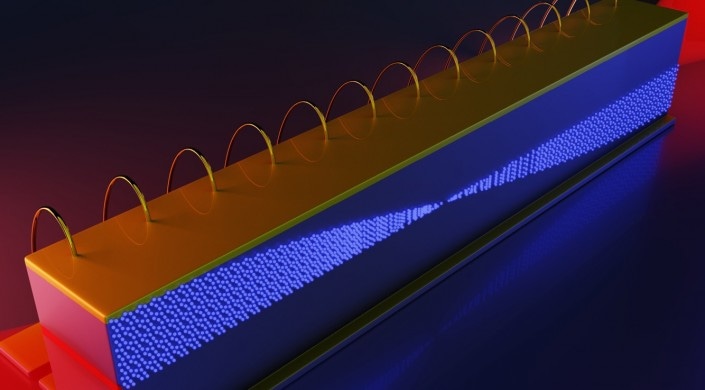May 2 2018
 Inside an infrared frequency comb in a quantum cascade laser, the different frequencies of light beat together to generate microwave radiation. (Credit: Jared Sisler/Harvard University)
Inside an infrared frequency comb in a quantum cascade laser, the different frequencies of light beat together to generate microwave radiation. (Credit: Jared Sisler/Harvard University)
There has been an exponential increase in cellular and Wi-Fi data traffic; however, without increasing the capacity of wireless links, all that traffic will eventually result in unacceptable bottlenecks.
Although the emerging 5G networks are a temporary solution, they are not a long-term fix. Therefore, scientists have been focusing on terahertz frequencies—the sub-millimeter wavelengths of the electromagnetic spectrum. The transfer of data at terahertz frequencies could be hundreds of times faster than prevalent wireless technologies.
In 2017, scientists from the Harvard John A. Paulson School of Engineering and Applied Sciences (SEAS) found out that an infrared frequency comb in a quantum cascade laser could provide an innovative path to produce terahertz frequencies. At present, they have revealed an innovative phenomenon of quantum cascade laser frequency combs, which would enable these devices to function as integrated receivers or transmitters that can encode information in an efficient manner.
The study has been reported in the journal Optica.
This work represents a complete paradigm shift for the way a laser can be operated. This new phenomenon transforms a laser—a device operating at optical frequencies—into an advanced modulator at microwave frequencies, which has a technological significance for efficient use of bandwidth in communication systems.
Federico Capasso, Robert L. Wallace Professor of Applied Physics and Vinton Hayes Senior Research Fellow in Electrical Engineering
Frequency combs are high-precision tools that are broadly used for the detection and measurement of different frequencies, or colors, of light. In contrast to traditional lasers that emit a single frequency, these lasers emit multiple frequencies at the same time, evenly spaced to appear like the teeth of a comb. At present, optical frequency combs are being used for various purposes, from the measurement of fingerprints of particular molecules to the detection of distant exoplanets.
However, this study was not related to the optical output of the laser.
We were interested in what was going on inside the laser, in the laser’s electron skeleton. We showed, for the first time, that a laser at optical wavelengths can operate as a microwave device.
Marco Piccardo, Postdoctoral Fellow, SEAS
Within the laser, the distinctive frequencies of light interact together to produce microwave radiation. The team found out that light within the laser’s cavity makes electrons to oscillate at microwave frequencies—which are within the communications spectrum. One can externally modulate these oscillations to encode information onto a carrier signal.
This functionality has never been demonstrated in a laser before. We have shown that the laser can act as a so-called quadrature modulator, allowing two different pieces of information to be sent simultaneously through a single frequency channel and successively be retrieved at the other end of a communication link.
Marco Piccardo, Postdoctoral Fellow, SEAS
“Currently, terahertz sources have serious limitations due to limited bandwidth,” said Capasso. “This discovery opens up an entirely new aspect of frequency combs and could lead, in the near future, to a terahertz source for wireless communications.”
Dmitry Kazakov (Harvard), Noah A. Rubin (Harvard), Paul Chevalier (Harvard), Yongrui Wang (Texas A&M), Feng Xie (Thorlabs), Kevin Lascola (Thorlabs), and Alexey Belyanin (Texas A&M) co-authored the paper. The Defense Advanced Research Projects and the National Science Foundation supported the study.